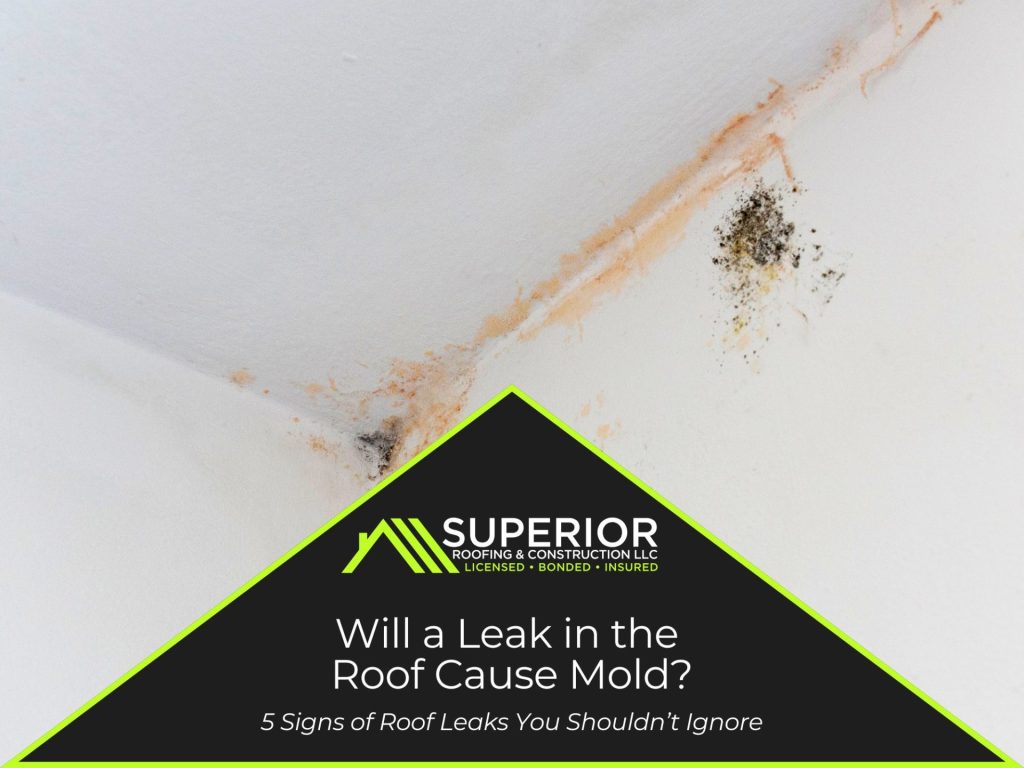
A small leak in your roof may not seem urgent until you discover visible mold growth quietly spreading inside your home or business. So, will a leak in the roof cause mold? The answer is yes, and the longer it’s left untreated, the more serious the water damage becomes.
In this article, we’ll walk you through how a leaky roof contributes to mold, how to detect trouble early, what kind of structural damage it can cause, and what to do if your roof is leaking.
How Roof Leaks Lead to Mold Growth
Mold thrives in moist, dark environments — exactly the conditions a leaky roof creates in attics, behind walls, or under flooring.
When water enters through damaged shingles, faulty roof flashing, or areas weakened by ice dams, it doesn’t always drip into your living space. Instead, it soaks insulation, wood, and drywall, often without any visible damage at first.
This leads to moisture buildup, and within 24 to 48 hours, visible mold growth can begin.
Over time, this silent invasion can impact indoor air quality, trigger allergies, and even affect the resale value of your property.
How to Detect Roof Leaks: 5 Signs of Roof Leaks
Early detection is key. The longer you wait, the more likely you’ll face costly repairs. Here are the common signs to help you spot a roof leak:
- Water Stain on Ceilings or Walls: A yellow or brown water stain is one of the most obvious signs of roof leaks.
- Musty Odors: Mold and mildew produce distinct smells in poorly ventilated areas.
- Peeling Paint or Sagging Drywall: Caused by prolonged exposure to moisture.
- Missing or Cracked Shingles: These allow water to seep in and cause hidden damage — especially after high winds.
- Moss or Mold on Exterior Walls: Indicates poor drainage or prolonged moisture exposure.
A thorough roof inspection by a roofing expert can reveal even the smallest issues before they escalate.
How Much Damage Can a Leaking Roof Cause?
A leaky roof can cause more than just ceiling stains, as it can lead to serious problems if ignored. Water can rot beams, damage rafters, and weaken the structure of your home. It can also ruin insulation, warp wood, and even cause electrical issues if it reaches wiring.
As moisture builds up, mold can grow quickly, spreading through walls and ceilings. Wet insulation also stops working properly, which means higher energy bills as your heating and cooling systems work harder.
In the end, small leaks can turn into big headaches. Acting early helps you avoid health risks and expensive roof leak repair down the line.
What To Do if Roof Is Leaking
Once you spot any warning signs, take action immediately:
- Contain the Leak: Use buckets and towels to minimize water damage.
- Photograph the Area: Document stains, warped surfaces, and visible mold growth.
- Schedule a Roof Inspection: Have a roofing expert assess the issue, including flashing, vents, and shingles.
- Request Prompt Roof Repair: Delaying repair will likely increase the extent of damage.
- Improve Attic Conditions: Add proper ventilation to reduce humidity and prevent future leaks.
- Stick to Regular Roof Maintenance: Seasonal checkups can prevent small issues from turning into major repairs.
Final Thoughts
Will a leak in the roof cause mold? Without a doubt. A leaky roof causes silent but serious damage, often out of sight until it’s too late. Watch for the common signs, act fast, and never underestimate the value of a timely roof inspection and prompt roof repair.
Contact Superior Roofing today for a professional roof inspection and fast, reliable roof leak repair. Our experienced team is here to protect your home or business by delivering lasting repairs and real peace of mind.